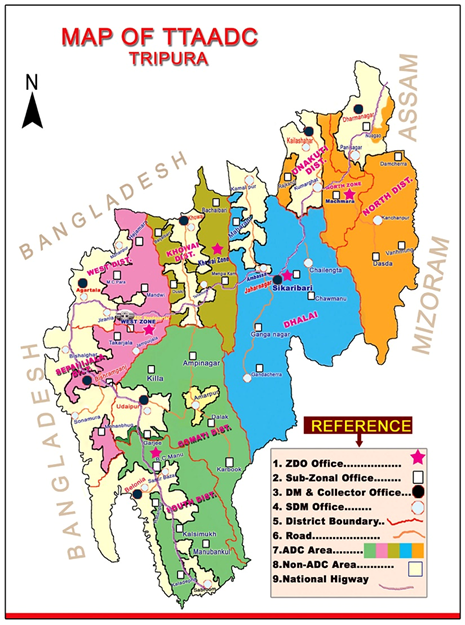Why in news?
- The newest political party in Tripura, the Tipraha Indigenous Progressive Regional Alliance (TIPRA) Motha, has created a flutter with its demand for Greater Tipraland.
- The party was floated in 2019 by Pradyot Bikram Manikya Debbarma – the son of Tripura’s last king.
- Tripura was a kingdom ruled by the Manikya dynasty from the late 13th century.
- This dynasty ruled Tripura until the signing of the Instrument of Accession with the Indian government in October 1949.
What’s in today’s article?
- Demand for Greater Tipraland
What is Greater Tipraland?
- Greater Tipraland is the core ideological demand of the TIPRA Motha.
- The objective is to carve out a new State for the 19 indigenous tribes of Tripura under Articles 2 and 3 of the constitution.
- Article 2 - Parliament may by law admit into the Union, or establish, new States on such terms and conditions as it thinks fit.
- Article 3 comes into play in the case of formation of new States and alteration of areas, boundaries or names of existing States by the Parliament.
- Regional extent of the proposed State

- It includes the region under Tripura Tribal Areas Autonomous district Council (TTAADC) and 36 villages out of it, within the Tripura State boundaries.
- The demand seeks to include every tribal person living in indigenous area or village outside TTAADC
- However, the idea doesn’t restrict toTripura tribal council areas.
- It extends to include Tiprasa (indigenous people of Tripura) spread across different states of India like Assam, Mizoram etc.
- It also includes those living in Bandarban, Chittagong, Khagrachari and other bordering areas of neighbouring Bangladesh.
How did the demand originate?
- Apprehension of the indigenous communities
- The demand mainly stems from the anxiety of the indigenous communities in connection with the change in the demographics of the state, which has reduced them to a minority.
- It happened due to the huge influx of refugees from East Pakistan. The flood of refugees led to bitter differences.
- From 63.77 per cent in 1881, the population of the tribals in Tripura was down to 31.80 per cent by 2011.
- The indigenous people have not only been reduced to a minority, but have also been dislodged from land reserved for them
- Ethnic conflict and insurgency
- Later, ethnic conflict and insurgency gripped the state, which shares a nearly 860-km long boundary with Bangladesh.
- The conflict between the tribals and the non-tribals escalated in 1980 and took the shape of armed insurgency.
- The demand for autonomous regions or separate statehood during this time metamorphosed to sovereignty and independence.
- However, after a political truce was reached between the State and the rebel groups, the demand for statehood was revived.
- Rise of Ethnic-Politics
- There has been a revival of ethnic nationalism in Tripura by the newly formed political party.
- It is trying to unite people from both tribal and non-tribal ethnic identity since 2019.
- This party claims that a separate state could alone alleviate problems faced by Tripuri tribes.
- Alleged discrimination faced by Tripura Tribal Areas Autonomous District Council (TTAADC)
- The TTADC receives two percent of the State budget while it has 40% of the State’s population.
- TTADC was formed under the sixth schedule of the Constitution in 1985.
- Its aim is to ensure development and secure the rights and cultural heritage of the tribal communities.
- It has legislative and executive powers and covers nearly two-third of the state’s geographical area.
- It also highlights the unfulfilled demands of revising National Register of Citizens (NRC) in Tripura.










